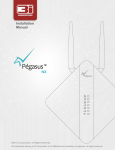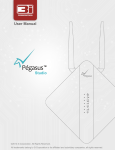Download Installation Manual
Transcript
Installation Manual Nx World’s Most Advanced Alarm Panel Communicator ©2014 3i-Corporation. All Rights Reserved. All trademarks belong to 3i-Corporation® or its affiliated and subsidiary companies, all rights reserved. Pégasus Nx Installation Manual v2.7| February 21, 2014 © 2014 3i-Corporation® and its affiliated and subsidiary companies, all rights reserved. All trademarks are the property of 3i-Corporation® and its affiliated and subsidiary companies. This product, including data and documentation are licensed to the user for its internal business purposes only and may not be disclosed, disseminated, sold, licensed, copied, reproduced, translated or transferred to any third party. Brazil Head Office [email protected] +55 11 38326102 Rua Coronel Botelho, 64 - Alto da Lapa - 05088-020 São Paulo – SP, BRAZIL India Innovation & Technology Center [email protected] #5, 1st Cross, Khykha Court, 1st Floor, Madiwala, Hosur Main Road, Bangalore , Karnataka - 560068 INDIA ii Table of Contents Introduction ............................................................................................................... 1 About the Installation Manual ............................................................................................................................... 1 What is Pégasus Nx? ............................................................................................................................................ 1 Contact Information or Comments ....................................................................................................................... 2 Technical Specifications ............................................................................................ 3 Pégasus Nx Features ............................................................................................... 10 Getting Started ......................................................................................................... 16 How to Assemble Pégasus Nx? ............................................................................... 19 Instructions.......................................................................................................................................................... 19 How to Wire Pégasus Nx? ........................................................................................ 39 Wiring Instructions .............................................................................................................................................. 39 Wiring Example ................................................................................................................................................... 39 Single-Mode: Normally Close (N.C.) Contacts without End of Line (EOL) Resistor ......................................... 42 Contacts without End of Line (EOL) Resistor..................................................................................................... 42 Single-Mode: Normally Close (N.C.) Contacts with End of Line (EOL) Resistor .............................................. 43 Single-Mode: Normally Open (N.O.) Contacts with End of Line (EOL) Resistor .............................................. 44 Single-Mode: Normally Close (N.C.) Contacts without End of Line EOL Resistor, with Tamper Recognition. 45 Single-Mode: Normally Close (N.C.) Contact with End of Line (EOL) Resistor, with Tamper & Wire Fault Recognition ......................................................................................................................................................... 46 Double-Mode: Normally Close (N.C.) Contacts without End of Line (EOL) Resistor ....................................... 47 Double-Mode: Normally Close (N.C.) Contacts without End of Line (EOL) Resistor, with Tamper Recognition ............................................................................................................................................................................. 48 Double-Mode: Normally Close (N.C.) Contacts with End Of Line (EOL) Resistor, with Tamper & Wire Fault Recognition ......................................................................................................................................................... 49 Double-Mode: Parallel Connection .................................................................................................................... 50 How does LEDs Work? ........................................................................................... 51 LEDs Description ................................................................................................................................................ 52 iii 1 Introduction About the Installation Manual This Installation Manual is aimed in providing technical information as a reference to the Pégasus™ Nx Ethernet+GPRS and Ethernet+GPRS+WiFi models. The installation manual can be used by 3i Corporation® authorized distributers and engineers to properly install the device. The installation manual also describes the technical specification related to the device. The end of this installation manual contains information related to various conditions and functionalities of LEDs. What is Pégasus Nx? Pégasus™ Nx Alarm Panel Communicator is an extremely compact, robust device in terms of communication interface for Alarm Panels. It brings the most innovative and reliable technologies for data communication to the Fire and Intrusion Alarm Panels prepared to operate only with conventional telephone lines. When energized, Pégasus™ Nx enters the Ethernet TCP/IP (Intranet/Internet) or GSM operator network via GPRS (Data Channel) or Wi-Fi Network (only in Ethernet+GPRS+WiFi model), and though it establishes connection with the Zeus™ Server. It creates an online communication channel between the monitored client and the Alarm Monitoring Station, allowing immediate transmission of all events generated by the alarm panel in the Contact ID Protocol. All information transmitted by the device is encrypted (AES Rijndael128/256 Bit) ensuring maximum confidentiality 1 The Zeus™ Server, on the other hand, is a multitask software that works as a virtual receiver, capturing the events transmitted by the device and transmitting them to the monitoring software like a conventional receiver simulating the communication protocol of Ademco-685, Sur-Gard MLR2-DG, Sur-Gard via TCP/IP, and Radionics D6600 receivers. Contact Information or Comments For general contact, technical support, questions or comments to report documentation errors and suggestions, email us at [email protected] or [email protected]. Our aim is to make this Installation Manual as helpful as possible. Keep us informed of your comments and suggestions for improvements. 3i-Corporation® appreciates feedback from the users of our information. 2 2 Technical Specifications Power Supply 1 Input Voltage Range 9VDC – 16VDC 2 Maximum Input Current Ethernet+GPRS: 350mA Etherent+GPRS+ WiFi: 450mA Battery 1 Battery Type Lithium-Polymer with inbuilt NTC thermistor 4 Battery Cable Length 65mm (Approx.) 2 Capacity 2000mAh 5 Battery Backup Up to 6 hours depending on network status 3 Nominal Voltage 3.7V 3 Processor 1 CPU ARM 32bit CortexM3 2 Clock 32Mhz Ethernet 1 Network Standard IEEE 802.3u compliant fast Ethernet 4 Ethernet Cable CAT5 crossover cable 2 Data Rate Full Duplex, 10/100Base TX Ethernet PHY 5 Protocols TCP/UDP 3 Auto Negotiation Enable or Disable 6 Speed Selection 10/100Mbps GSM/GPRS 1 Modem Quad-band - 850, 900, 1800, and 1900 MHz 6 SIM Card Holder Dual SIM support 2 Protocol Support TCP/UDP 7 Antenna: Impedance 50Ω 3 Antenna Type External Male SMA DAM (Dipole Antenna Module) 8 Antenna: Peak Gain 2.0dBi 4 4 Antenna: Frequency Range 824-960MHz, 17102170MHz 5 Remote Firmware Update Available via FOTA (Firmware Over-TheAir) 9 Antenna: Return Loss -4.4dB Wi-Fi (Only in Ethernet+GPRS+WiFi Model) 1 Network Standard EEE 802.11 b/g 6 Security Types WPA, WPA2, None 2 Typical WLAN Sensitivity 88dBm at 8% PER (Packet Error Rate), 11Mbps 7 Typical WLAN Transmit Power +19.5dBm at 11Mbps, CCK (11b) 8 WLAN Antenna: Frequency Range 2.4 - 2.5GHz WLAN Antenna: Return Loss 10dB -74dBm at 10% PER, 54Mbps 3 WLAN Antenna: Type External female SMA 4 WLAN Antenna: Impedance 50Ω 9 5 WLAN Antenna: VSWR 2.0 Max 10 WLAN Antenna: Peak Gain Dipole Antenna Module (DAM) +15.0dBm at 54Mbps, OFDM (11g) 2.0dBi 5 Zones 1 Number of Wired Zones Two (extendible to four zone inputs) 2 EOLR (End of Line Resistor) 1K, and 2.2K 3 Supporting Modes Single-mode and double-mode zone interfacing 2 PGM- Relay Supports 125VAC/60VDC @2A PGMs 1 PGMs-OC Supports 200mA, 16V sink current per PGM Telephone Line Connection 1 Maximum 100VAC, 48VDC Telephone Line Voltage Detection 2 Minimum 3VDC Telephone Line Voltage Detection 6 Virtual Telephone Line Output 1 Constant Current Source for Alarm Panel 25mA, 20V Serial Port 1 Serial Debug (UART) Interface 10 PIN male, rightangled box header 2 Baud Rate 115200 baud 3 Use For configuration, firmware upgrade and to view debug messages USB 1 USB 2.0 Device Interface Mini -B USB 3 USB Full Speed 12Mbps 2 Cable Type USB cable with ferrite core (recommended) 4 Use For configuration, firmware upgrade and to view debug messages 7 LEDs (Top to Bottom) 1 LED #1 Power ON Status 5 LED #5 GSM Status 2 LED #2 Telephone Line Cut Off 6 LED #6 Alarm Panel Return Connection 3 LED #3 Online 7 LED #7 Wi-Fi Status 4 LED #4 (only in Ethernet+GPRS+WiFi model) GSM Signal Strength Operational Specifications 1 Operating Temperature -20℃ - 60℃ 2 Relative Humidity 10-90%, no condensation 3 Storage Temperature -20℃ - 60℃ 2 Use Reports enclosure violation Tamper Switch 1 Tamper Type Internal 8 Board Dimensions 1 Length 82mm 3 Thickness 1.6mm 2 Width 80mm 4 Number of Layers of PCB Four 3 Height 4.2mm Enclosure Dimensions 1 Length 112mm 2 Width 112mm Note: POWER SUPPLY, ETHERNET (RJ45)/USB/SERIAL CABLES, EOL RESISTORS AND SIM CARDS ARE NOT PROVIDED IN THE PACKAGE. You need to purchase the above mentioned accessories (except SIM CARDS) from our authorized distributer or from any electronic shop as per the technical specifications provided in this section. You can get SIM CARDS from the Network Service Provider of your choice. Directly contact the Network Service Provider for subscription details. 9 3 Pégasus Nx Features Built-in world-class GSM modules from Telit®; Powered by ARM® Cortex 32 Bits Processor; Communicates with monitoring station via GSM/GPRS (2xSIM Cards), Ethernet (TCP/UDP, fixed or dynamic IP), Wi-Fi* (2x Access Points), Telephone Line, SMS, CSD and Voice Call; NOTE: *WiFi interface is only available in the Ethernet+GPRS+WiFi model. Built-in GSM Jammer Detector, essential for security systems based on GSM; Transmits by SMS or CSD in case of data network failure and monitored client phone line cut; Exclusive FREE CALLS technology, which allows the sending of Alive packets through voice channel; Compatible with any alarm panel, which communicates in the Contact ID Protocol; 10 Allows simultaneous transmission to two different monitoring station using different interfaces; Supports 8 fixed or dynamic IPs; Allows the verification of the monitored customer's telephone line; Has phone line cut detector with configurable delay; Allows phone line switching for alarm panels download; Allows remote configuration and firmware update; Has 4 PGMs (3 Open Collector and 1 Relay) that can be controlled remotely; Has 2 zones, which are extended to 4 zone inputs; Loop test - Allows tests of alarm panel operation; Supervises the physical connection with the alarm panel; Allows local or remote monitoring and analysis of its behavior and routines; Allows local or remote GSM Signal measurement; Encrypted data transmission (128/256 bits); 11 2000mAh internal lithium-polymer battery; Built-in tamper switch; Device status via ECO SMS; Modem firmware update over-the–air (FOTA); 512KB of memory for Logs, stores up to 5000 events. 12 4 Pégasus™ Nx Nomenclature Wi-Fi Antenna GSM Antenna (only in the Ethernet+GPRS+WiFi model) LEDs Front Door 13 Front Panel Terminal Header M3.5xL35 Product Mounting Screw 14 SIM Cover SIM Cover Mounting Screw Product Mounting Plate Placeholders Rear Panel Product Mounting Plate 15 5 Getting Started The new Pégasus™ Nx comes with a modern and stylish enclosure, which is compact, made up of premium, highly durable material. The exclusive, modern and informative box packaging designed for our new Pégasus™ Nx brings to the product a quality level never seen in the electronic security market. Depending on the module, the box packaging contains the following antenna types: Module Antenna Type GSM Antenna Wi-Fi Antenna GSM/GPRS+Ethernet GSM/GPRS+Ethernet +Wi-Fi 16 17 Pégasus™ Nx Packaging Box Wi-Fi Antenna Pégasus™ Nx Module Blister GSM Antenna 18 6 How to Assemble Pégasus Nx? Instructions Warning: Installation of the device should be done by the trained 3i-Corporation® authorized service personnel only. Always use genuine 3i-Corporation® approved accessories with the device. Pégasus™ Nx is extremely easy to assemble because of its state-of-art design. Just follow the step-by-step procedure to quickly assemble the device. To assemble Pégasus™ Nx 1. Open the Front Door of the device. DO NOT apply extreme force. 19 2. Using an appropriate screwdriver, loosen the M3 x L32 Product Mounting Screw in the anticlockwise direction until it is fully released. Remove the screw by pulling it out of the Front Panel, see the below images. 20 21 3. On the Rear Panel (backside) of the device, locate the SIM Cover secured by a M3 x L6 Machine screw, see the below image. 4. Using an appropriate screwdriver, loosen the screw in the anti-clockwise direction until it is fully released. 22 5. Open the SIM Cover by sliding it horizontally in the outward direction, and then lifting it up as displayed in the below image. 6. Pégasus™ Nx is built-in a dual SIM card holder, the SIM slot towards the PCB is designed to hold SIM card #2, whereas the SIM slot projecting towards the SIM cover holds SIM card #1. 23 7. Insert SIM card #2 in the SIM slot #2. Make sure you insert the SIM card exactly as shown in the below image. 8. Insert SIM card #1 in the SIM slot #1. Make sure you insert the SIM card exactly as shown in the below image. 24 9. Once the SIM cards are installed properly, close the SIM cover and secure it using the M3xL6 Machine Screw. Tighten the screw in the clockwise direction. 10. Tighten the GSM Antenna (External male SMA, Dipole Antenna Module) on the GSM Antenna Connector (right side of device) in the clockwise direction. Tighten the Wi-Fi Antenna (External female SMA, Dipole Antenna Module) on the Wi-Fi Antenna Connector (left side of device) in the clockwise direction, see the below images. 25 Note: If your module does not have Wi-Fi, skip the Wi-Fi antenna installation step and proceed only with the supplied GSM antenna installation. When fixed properly, both the antennas should look firm and stable on the module as shown in the below image. 26 11. Remove the Front Panel of the device by pulling it in the outward direction from position 1 & 2, and pushing it from the backside from position 3 & 4, see the below images. 27 1 2 4 3 28 12. Auto-negotiation: To enable auto-negotiation, remove Jumper Shunt from Jumper Pins at J4 position. 29 13. To disable auto-negotiation, do not remove the Jumper Shunt from the Jumper Pins at J4 position. 14. To get Ethernet speed of 100Mbps, remove Jumper Shunt from Jumper Pins at J3 position. 30 15. To limit Ethernet speed to 10Mbps, do not remove Jumper Shunt from Jumper Pins at J3 position. 16. Remove the Tape holding the Battery Connector. Connect the Battery Connector to the onboard connector, see the below images. 31 When the battery connector is properly connected to the battery connector, LEDs starts blinking. 32 17. After the Battery Connector installation, fix the Front Panel back on the Rear Panel and secure, DO NOT secure it using the M3.5xL35 Product Mounting Screw, see the below image. 18. Close the Front Door of the device. 33 19. Connect the Ethernet Cable (CAT5 crossover cable) to the RJ45 port of the device, see the below image. 34 20. Install the Product Mounting Plate on the wall where you want to fix the device. 35 Wall - Side View Wall Mounting Plate - Side View 21. Fix the device on the Product Mounting Plate and tighten the Product Mounting Screw. Install it properly as shown in the below image. A properly installed device looks upright and stable. 36 Wall - Side View Pégasus™ Nx – Side View Product Mounting Bracket – Side View Product Mounting Screw 37 Pégasus™ Nx fully installed on the wall using the Product Wall Mounting Bracket. WALL 38 7 How to Wire Pégasus Nx? Wiring Instructions Warning: Wiring should be done by the trained 3i-Corporation® authorized service personnel only. Never install the device during lightning or storm. Always use genuine 3i-Corporation® approved accessories with the device. TURN OFF power supply during wiring. Wiring Example Pégasus™ Nx is built in four terminals: R1, T1, RING and TIP for alarm panel connections. These are fully compatible with any alarm panel that follows Contact ID Protocol. Telephone Line and Handset terminals that can be used to connect wires from telephone exchange and telephone handset respectively. The programmable SPDT relay output can be used for various crucial operations. For example, switching a high current powered bell or siren. Three programmable open collector outupts can be used to activate a buzzer or strobe light, open or close doors etc. When any of the three on board programmable open collector outputs is activated, Pégasus™ Nx triggers any device connected to it. 39 40 Pégasus™ Nx is built-in two zones, which are extended to four zone inputs. The device supports zone input wiring in both single-mode and double-mode. A sensor or detector can be connected in nine different ways. Single-Mode: Normally Close (N.C.) Contacts without End of Line (EOL) Resistor Single-Mode: Normally Close (N.C.) Contacts with End of Line (EOL) Resistor Single-Mode: Normally Open (N.O.) Contacts with End of Line (EOL) Resistor Single-Mode: Normally Close (N.C.) Contacts without End of Line (EOL) Resistor, with Tamper Recognition Single-Mode: Normally Close (N.C.) Contact with End of Line (EOL) Resistor, with Tamper & Wire Fault Recognition Double-Mode: Normally Close (N.C.) Contacts without End of Line (EOL) Resistor Double-Mode: Normally Close (N.C.) Contacts without End of Line (EOL) Resistor, with Tamper Recognition Double-Mode: Normally Close (N.C.) Contacts with End Of Line (EOL) Resistor, with Tamper & Wire Fault Recognition Double-Mode: Parallel Connection 41 Single-Mode: Normally Close (N.C.) Contacts without End of Line (EOL) Resistor Contacts without End of Line (EOL) Resistor 42 Single-Mode: Normally Close (N.C.) Contacts with End of Line (EOL) Resistor 43 Single-Mode: Normally Open (N.O.) Contacts with End of Line (EOL) Resistor 44 Single-Mode: Normally Close (N.C.) Contacts without End of Line EOL Resistor, with Tamper Recognition 45 Single-Mode: Normally Close (N.C.) Contact with End of Line (EOL) Resistor, with Tamper & Wire Fault Recognition 46 Double-Mode: Normally Close (N.C.) Contacts without End of Line (EOL) Resistor 47 Double-Mode: Normally Close (N.C.) Contacts without End of Line (EOL) Resistor, with Tamper Recognition 48 Double-Mode: Normally Close (N.C.) Contacts with End Of Line (EOL) Resistor, with Tamper & Wire Fault Recognition 49 Double-Mode: Parallel Connection 50 8 How does LEDs Work? Pégasus™ Nx is built-in seven on-board LEDs, which emits light through its front door under specific conditions. The blinking and behavior of LEDs is crucial and helps you to analyze the status of device. Power ON Status Online GSM Status Wi-Fi Status (only in Ethernet+GPRS+WiFi model) Telephone Line Cut Off GSM Signal Strength Alarm Panel Return Connection 51 LEDs Description LEDs Status Power ON Status This led indicates Power ON/OFF and device Sleep Mode status Function LED Blinking: 5 sec ON Indicates that device is in the working & 0.2 sec OFF state LED Blinking: 0.1 sec ON & 0.1 sec OFF Indicates that device is in the Sleep mode. This state can occur during battery fault or low battery percentage. LED is OFF Device is not working. LED ON Telephone line NOT connected to the device LED OFF Telephone line connected to the device LED ON Device CONNECTED to the Zeus™ Server This led indicates whether device is connected or to the Zeus™ Server or not LED OFF Device NOT connected to the Zeus™ Server GSM Signal Strength LED Blinking: 0.002 sec ON & 0.002 sec OFF Indicates that device is in the jammed state Telephone Line Cut Off This led indicates whether telephone line is connected or disconnected to the device Online This LED represents GSM signal strength status and Module Jammer status 52 LEDs Status LED Blinking: 0.5 sec ON & 0.5 sec OFF LED Blinking: 2 sec ON & 2 sec OFF GSM Status This LED indicates whether GSM module is ON or OFF Alarm Panel This LED indicates whether Alarm Panel is connected to virtual line or not Wi-Fi Status (only in Ethernet+GPRS+WiFi Model) This LED indicates whether Wi-Fi is connected to Access Point or not Function Indicates that GSM signal strength is less than12dB Indicates that GSM signal strength is greater than12dB & less than 20 dB LED Blinking: 0.5 sec ON & 5 sec OFF Indicates that GSM signal strength is greater than 20dB LED OFF GSM modem NOT enabled LED OFF GSM module OFF LED Blinking: Fast blinking (1 sec) Net search/not registered/turning off LED Blinking: Slow blinking (3 sec) Registered full service LED OFF Alarm panel NOT connected to the virtual line. LED ON Alarm panel CONNECTED to the virtual line. LED OFF Wi-Fi NOT enabled Module NOT CONNECTED to internet via Wi-Fi LED ON Wi-Fi enabled Module CONNECTED to internet via Wi-Fi 53































































![UFM-30CTL Operation manual[PDF:4.1MB] - FOR](http://vs1.manualzilla.com/store/data/005676883_1-d2048345a5eb1a6d8c39e09dd604009b-150x150.png)
